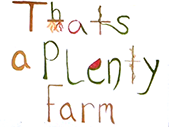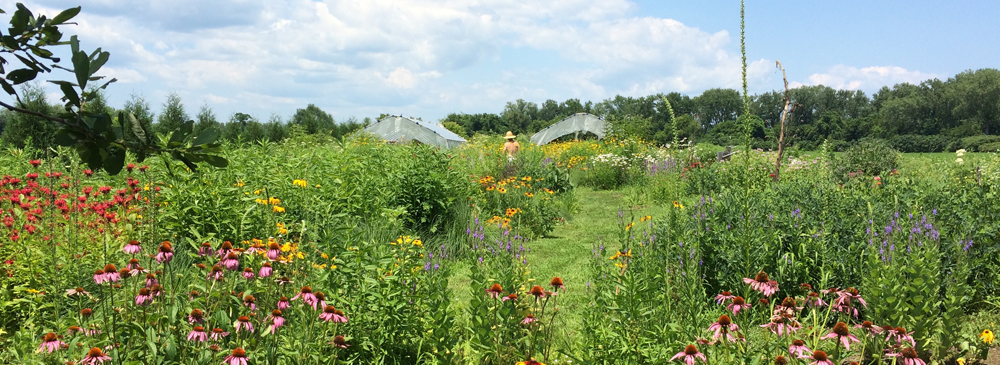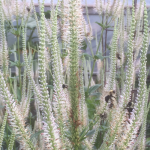Grow a nectar garden for the full pollinator season
We’ve heard about the distress to honeybees, described as Colony Collapse. And, since one out of every 7 bites of food you take is a bite made possible by a pollinator, this is a concern to us humans. We have also learned that NATIVE bees do the bulk of the pollination work. Native bees and other pollinating insects are in distress as well, due to the accumulation of neonicotinoid pesticides and loss of ecodiversity.
Here in western Massachusetts, we have more than 400 different species of Native Bees. Most live independently, in the ground or in dried stalks of woody plants.
What’s the difference between honeybees and native bees?
- Honeybees are “managed”—they live in hives and require tending by beekeepers. Honeybees are not native to the U.S., they were imported from Europe along with the food plants that require them.
- Native bees are just as hard working, but local. Most live singly—in tree stumps and snatches of hollow branches and in abandoned mouse holes. Bumblebees are an exception—they do live in colonies. Most native bees have no stinger, as they have no colony to protect.
Hands-off care of your pollinator habitat
Here’s what’s great about Pollinator Habitat gardens: you will have beautiful flowers blooming all season. If you are a fan of the BBC’s TV show “Downton Abbey,” you saw gorgeous gardens behind the family mansion—those looked to me exactly like our pollinator garden.
Best of all: it’s recommended to leave the bees undisturbed to do their work—so don’t go crazy managing the habitat. Let it grow! This includes dandelions, as they are often in bloom when few other flowers are. Our native bees depend upon dandelions and clover to get them through times of scarcity.
Pollinator Habitat Seeds & Plants for Sale
Our own seeds—supporting native bees, bumble bees, butterflies and other beneficial insects—are now available by mail. These seeds were grown and harvested by hand at That’s A Plenty Farm & Pollinator Habitat, the first pollinator habitat in Western Massachusetts funded by the USDA’s Natural Resources Conservation Service (NRCS). Order your seeds online, in our STORE.
It’s easy to provide beautiful habitat for native pollinators! Plant these outside in the fall and watch them come to life the following spring.
Starting in June 2020, for LOCAL pick-up only (no shipping), we have first-year seedlings and also mature plants for sale. We are also offering a Pollinator CSA. Contact us with questions or to set an appointment: [email protected]
or call Cathy’s cell: 413.559.9551
Plant your edges
Plant the edges of your yard or garden or farm with the perennial plants that native bees and butterflies require all season long. Add some bee-nesting shelters and a shallow, sloping dish of drinking water, then leave the pollinator garden undisturbed.
Please plan to save seeds from your plantings (your plants should mature in the second year) each fall and give them to others. These are open-pollinated seeds, and perennials. Some plants may not appear until the second year.
Bloom nonstop, early to late
We offer two seed collections, our Pollinator Garden Collection (12 perennial pollen & nectar plants) and an extension collection, Bee & Butterfly Boost (4 perennial plants). We also offer seeds of Veronicastrum virginicum and Pycnanthemum flexuosum, both of which have proven to be fantastic bee magnets. Both species are in serious decline in New England.
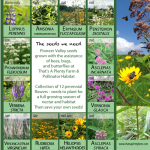 Best Practices for pollinator habitat: Plant at least 3 different varieties of plants (multiples of each, planted in clusters) for early-, mid- & late-season blooming. Offer a range of flower shapes and colors.
Best Practices for pollinator habitat: Plant at least 3 different varieties of plants (multiples of each, planted in clusters) for early-, mid- & late-season blooming. Offer a range of flower shapes and colors.
Pollinator Habitat Seed Collection
Visit our STORE to purchase pollinator seeds.
EARLY Blooming
- Amsonia tabernaemontana – Eastern bluestar
- Lupinus perennis – Sundial lupine
MID Blooming
- Eryngium yuccifolium – Rattlesnake master
- Penstemon digitalis – Beardtongue
- Asclepias incarnata – Rose milkweed
- Vernonia glauca, Upland ironweed
- Asclepias syriaca – Common milkweed
MID/LATE Blooming
- Heliopsis helianthoides – Smooth ox-eye sunflower
LATE Blooming
- Rudbeckia hirta – Black-eyed Susan
- Verbena stricta – Blue vervain
- Veronicastrum virginicum – Culver’s root
- Scutellaria incana – Hoary skullcap
Expand your pollinator garden with additional perennials!
Bee & Butterfly Boost
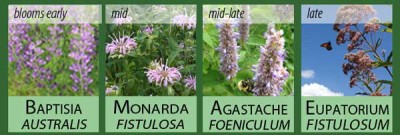
Visit our STORE to purchase pollinator seeds.
EARLY Blooming
- Baptisia australis – Blue wild indigo
MID Blooming
- Monarda fistulosa – Wild bergamot
MID–LATE Blooming
- Agastache foeniculum – Anise hyssop
LATE Blooming
- Eupatorium fistulosum – Joe Pye weed
Threatened: Veronicastrum
Veronicastrum virginicum
Culver’s root
MID Blooming
A beautiful, 3ft–4ft tall plant with spiky white flowers. A good cut flower. Our bees went crazy for it in 2015. This lovely plant is listed as Threatened in Massachusetts and New York, and Endangered in Vermont.
Sweetly-scented Pycnanthemum
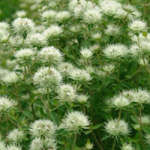 Pycnanthemum flexuosum
Pycnanthemum flexuosum
Appalachian mountainmint
MID blooming
The aromatic, silvery white, globular flowers of Pycnanthemum flexuosum are attractive to bees, and this is the larval host for the Gray Hairstreak butterfly. Blooms summer-to-fall. 2–3 ft tall, spacing 12 inches. A soil stabilizer for slopes and erosion control. A good cut flower. Will not take over the garden like other mints.
Visit our STORE to purchase pollinator seeds.
